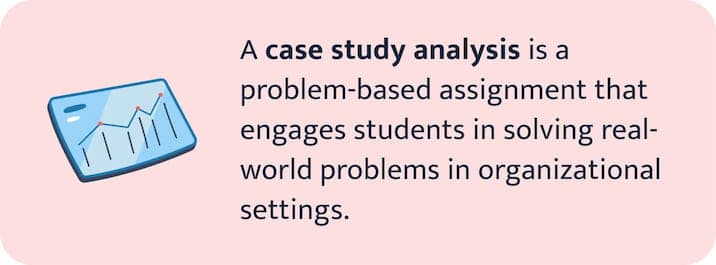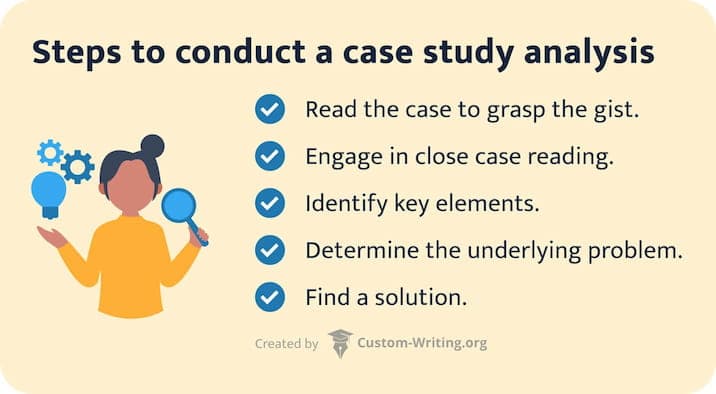Case Study Analysis Generator
Case studies are common assignments a student may get from their professor in literally any course. This academic research task urges students to choose an object of analysis – an organization, a group of people, or a situation – and take a comprehensive look at it, building their argument on the studied theories and concepts.
🔢 Case Study Answer Generator: How to Use It?
If you’re new to case study analysis and want clear guidance for completing such a task, welcome to try out the case study answer generator. It’s an automated tool that can process the data about your case and suggest workable, structured case study analysis for your further use.
To use the tool, you need to:
- Provide the case for analysis
- Determine the problems and tasks you need to solve
- Click “Generate” and enjoy the result
Note that the case study answers are AI-made and should be used for reference and inspiration only.
🤩 Case Study Analysis Generator: The Benefits
Using our case study analysis generator comes with a great number of advantages compared to manual case processing or searching for ready-made analytical content online.
Our case study generator is:
| 🌀 Universal | Our tool is universally applicable to study-related assignments on case study analysis and practical, work-related tasks for business case analysis. |
|---|---|
| 🤖 AI-powered | The instrument uses smart, advanced AI algorithms to process data and generate case study solutions based on the provided data. Thus, it can deliver nuanced, informative insights of the human level. |
| 🆓 Free | You don’t need to pay for using our case study analyzer; it’s free of charge and comes with no strings attached. |
| 🧚 Intuitive | There’s not much required from the user to get a workable case study analysis; you only need to feed the case into the system and indicate the questions, objectives, or problems the tool should resolve. |
Using an automated case study analysis tool offers numerous benefits, as you see, but nothing substitutes personalized assistance. If you're looking for such, employ a case study writing service to get connected to a skilled writer who can craft a detailed and professionally written analysis on any topic. Whether you need help with research, writing, or formatting, this resource ensures your case study meets the highest academic standards.
🖇 What Is a Case Study Analysis?
By definition:
A case study analysis is a problem-based assignment that advances students’ skills by engaging them in solving real-world problems in organizational settings.
This is usually done by presenting a case and offering students an exercise to:
- Identify the underlying problems and their causes
- Conceptualize those problems using the learned theories
- Find applicable solutions and recommendations for improving the situation

Such an exercise allows students to engage with real-life scenarios within their professional area more deeply and learn to link theory and practice for resolving a wide range of issues.
💼 Case Study Analysis in Business
Case studies are not only an educational tool testing the students’ ability to employ systemic critical thinking. As a method of critical inquiry, they are widely applied in business practice.
For instance:
- A company that has identified a problem or experienced a failure in its new product line launch can employ case study analysis to uncover the reasons underlying those issues.
- Business case analysis is also informative and helpful in terms of giving a company a better understanding of new techniques, strategies, and approaches their competitors have used to attain success.
- Case study insights can thus inform practical steps and changes within a company aimed to remove a bottleneck, improve performance, or launch a new product or service.
🆚 Case Study Vs. Case Analysis
Overall, cases can be analyzed in a number of ways, and there is a subtle difference between a case study and case analysis; it mainly relates to the degree of theorization involved in the process.
- Case study is a more academic endeavor; it involves analysis that links a real-life situation to underlying business concepts, relationships, and theories and informs the decision-making process with theoretical insights.
- Case study analysis is a more applied, problem-based task that involves less academic theory use and more practical decision-making based on problem identification.
📍 Steps to Conduct a Case Study Analysis
Writing a case study analysis may initially seem intimidating, so you need a structured approach to this assignment. Here are the steps that separate you from an insightful, detailed case study paper.

#1 Read the Case to Grasp the Gist
The first reading of your case study should involve a general overview of the case to determine the general context and background for further analysis.
So:
It’s not necessary to write down every detail and memorize who the main actors of the case are; you should basically capture what the case is about and what business aspect it deals with.
#2 Engage in Close Case Reading
Now that you have captured the overall content of your case (whether it’s a problem with entering new markets or a staffing issue to resolve), it’s time for closer reading of the text.
You need to take notes of:
- The company’s name
- Business activities
- Key stakeholders
- Key case participants
This data will simplify analysis and enable you to navigate case data more easily while theorizing it.
#3 Identify Key Elements
Next comes the analytical stage, at which you should determine:
- Who your main stakeholder groups are (whose interests are involved and whether they coincide or conflict in this case)
- What issues the case touches upon (price raise, new market entry, addressing the competition, finding a new product idea, etc.)
- What events and relationships are involved.
These details will give you a concise image of the situation, the actors’ positions on the problem, and the consequences of their actions.
#4 Determine the Underlying Problems
Now that you understand who advocates what in the case study, it’s time to dig deeper and go beyond the symptoms of organizational problems lying on the surface. Those symptoms should be analyzed using relevant theories and business knowledge to identify the core problems they point to. Once the problem is correctly spotted, you can proceed to the final stage of your analysis.
#5 Find a Solution
Based on the identified problem and theories you engage in this analysis, you can develop a set of recommendations and alternative solutions that can help a company avoid the situation to which it currently heads (or is already experiencing). The main part of recommendations is to back them with data and scientific knowledge; this way, they will sound competent and authoritative.
🖋 Case Analysis Example
Here is a sample business case and its structured analysis that you can get from our automated tool.
Business Case: Launching a New Product - “SmartHome+”
- Company: The company is looking to launch the new product, SmartHome+, and achieve market success.
- Customers: The end-users who will purchase and use the SmartHome+ product.
- Marketing Team: Responsible for product promotion and positioning.
- Product Development Team: Tasked with creating and refining the SmartHome+ device.
- Sales Team: In charge of distributing and selling the product.
- Investors/Shareholders: Interested in the product’s profitability and return on investment.
- Competitors: Rival companies that may react to the new product launch.
- Market Saturation: The market is saturated with smart home devices, making it challenging to differentiate SmartHome+.
- Consumer Skepticism: Customers may be skeptical about the value and security of yet another smart home product.
- Technical Challenges: Development issues or product defects could delay the launch or lead to negative customer reviews.
- Marketing Strategy: Creating an effective marketing strategy that distinguishes SmartHome+ from competitors is a challenge.
- Pricing: Determining an optimal price point that maximizes profit while remaining competitive.
- Distribution: Ensuring the product reaches the right retailers and online platforms.
- Product Differentiation: Invest in unique features or capabilities that set SmartHome+ apart from existing competitors.
- Quality Assurance: Rigorous testing and quality control during the development process to minimize technical issues.
- Comprehensive Marketing Plan: Develop a multi-channel marketing strategy emphasizing the benefits, security, and user-friendliness of SmartHome+.
- Pricing Strategy: Conduct thorough market research to determine the ideal price point, considering production costs and customer willingness to pay.
- Distribution Partnerships: Collaborate with established retailers and e-commerce platforms to expand product availability.
- Market Research: Prioritize market research to identify specific customer needs and preferences for SmartHome+.
- Innovation: Continue to invest in research and development to enhance SmartHome+ features.
- Quality Control: Maintain strict quality control measures to ensure a reliable product.
- Marketing Campaign: Launch a comprehensive marketing campaign, highlighting unique features and security aspects.
- Pricing Analysis: Conduct regular pricing analyses to adapt to market changes and remain competitive.
- Distribution Channels: Forge strong distribution partnerships to expand product availability and reach.
By following these recommendations, the company can address potential challenges, differentiate SmartHome+, and increase the likelihood of a successful product launch in a competitive market.
Thank you for reading this article! If you need to summarize an extensive case or turn it into structured notes, check our summarizer and notes generator.
❓ Case Study Answer Generator FAQ
The first step is a close review of the case you’re given. Study all the details, find out the case’s background, and identify the context and core problems requiring focus. After that, you may determine the key stakeholders, events, and relationships between them, choose an appropriate theory for the problem’s analysis, and offer a systematic analysis with workable recommendations and solutions.
Every case study should include an introduction with all relevant facts and problems in the spotlight. Then comes the background analysis, which allows a more nuanced understanding of the context and issues of concern. The problem is the third component, without which a case wouldn’t represent a problem requiring a solution. The final part is the recommended solution, which is developed based on the theories and class readings.
There are many valuable case study materials online, with some researchers and journalists specializing in case study research and presentation. Thus, you can easily locate many informative, structured case studies in business resources, on the companies’ official websites, and in academic databases. Our website also contains many valuable case study materials for consultation and inspiration.
There is no universal standard for the case study’s length, and the word count for your case study task will be set by the professor. As a rule, case studies may take from 1 to 5 pages, depending on the analytical depth required from you and the academic level at which you’re currently studying.
Updated: